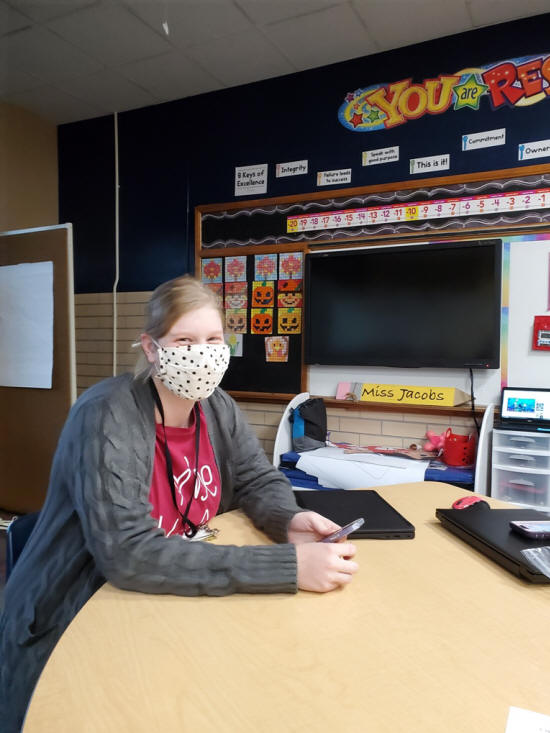|
 On December 13 and 14, 2021, the Illinois
Association of Regional Superintendent of Schools, Regional Offices
of Education and Intermediate Service Centers held the conference.
The ROE decides state needs and what is important for leaders to
see. During the conference, educators from across the state learned
practical strategies they could implement in their classrooms.
Social emotional learning, instructional coaching and math were
among topics covered. On December 13 and 14, 2021, the Illinois
Association of Regional Superintendent of Schools, Regional Offices
of Education and Intermediate Service Centers held the conference.
The ROE decides state needs and what is important for leaders to
see. During the conference, educators from across the state learned
practical strategies they could implement in their classrooms.
Social emotional learning, instructional coaching and math were
among topics covered.
Mrs. Lessen teaches third grade and Miss Jacobs teaches fifth
through eighth grade special education. C-EL
Principal/Superintendent Mrs. Laura Irwin said it was a great honor
for these teachers to be chosen as conference presenters.
The call for submissions for the conference was last April. Lessen
and Jacobs sent in a paragraph describing their presentation and
were chosen for a short list of possible presenters. They then had
to submit a proposal with a session description, title and target
audience. In July, they heard their presentation was chosen.
Jacobs and Lessen’s presentation focused on how math workshops
support universal design for learning. These are principles that
make learning accessible. Just as wheelchair ramps make places
accessible, lessons need to be accessible for all students.

Jacobs said one focus was how to set up schedules and routines in
classrooms, so students know what to expect and how to be
successful.
Additionally, Lessen and Jacobs talked about how problem-solving
tasks help shape children as mathematicians.
For example, they said when going into a store, no one will tell you
that you need to add up prices to know how much you are spending.
You must mentally keep an account.
The teachers have asked students: “You have $20 to
spend. What can you buy?”

CEL teacher
Tiffany Lessen
Lessen said it makes students think about costs. Jacobs said it also
gets kids interested and helps them see how they can use math skills
in real life.
Another example Lessen likes using is having her students plan a
thanksgiving dinner and go to a store’s website. She said as
students choose items for their dinner, they realize how expensive
everything is. Introducing authentic tasks can help students beyond
the classroom.
Their presentation highlights included discussing how games are
often an important, but overlooked aspect of math workshops. One
type of games Jacobs uses is what they call “evergreen” games
because they can be used with any math concept. With these games,
Jacobs said they teach the rules once and can then change out the
skills students are practicing.
The games can be adapted to all grade levels.
For example, if students are playing “war” with
cards, they might have to flip over three cards and to make a
number, and compare a three-digit number. They may flip two cards
and then must make a fraction. One game called NIM requires skip
counting and students fill in squares to reach the tray of cookies.

In another game, as they count and fill in squares, the goal is to
not be the person who gets to the end first and must “walk the
plank.” Lessen said strategy is involved when players do not know
what number their partner will write on a square. Students keep
going back and forth until all squares are filled in.
_small.jpg)
CEL teacher
Mackenzi Jacobs shows how to play the card game Garbage to practice
math skills.
One game demonstrated was “Garbage” in which each player has 10
numbered cards (photo). If using multiples of five, the five card
would go in the first spot, the 10 card in the second spot and so
on. The goal is to put all their cards in a sequence. This game can
build up multiplication skills. Younger children can play the game
and count by ones or twos.
Since game rules require students to talk, listen, collaborate and
take turns, they are practicing their math skills. Jacobs tells
parents to play board games with their children, which can help them
develop math skills when they do something like rolling dice.
[to top of second column] |

_small.jpg)
Tiffany Lessen
and Mackenzi Jacobs demonstrate a math game.
As they presented, Lessen and Jacobs gave teachers games they could
go back and immediately use in their classrooms. Lessen said they
also gave teachers planning guides and tools with a bank of
routines.
At other sessions, Lessen and Jacobs learned about other good math
games.
They also learned ways to improve Illinois Assessment of Readiness
test scores through seeing samples of written responses on a state
test and what makes examples good. In math responses, students must
explain math concepts.
In one session, Lessen saw how to implement math games with more
complex skills for older students.
At the monthly Region 17 math trainings, Jacobs said they will be
able to share what they learned with other area teachers.
Rather than textbooks, these teachers usually use a curriculum
developed with instructional math coaches Janet Moore and Hailey
Pocic-Burt.
As the students learn math, they go through four rotations. In one
station, students meet with the teacher in small groups. Here the
teacher sees what students are doing and provides lessons targeted
to their specific needs. There is an independent work section
students do in their seats doing skills practice or journal
problems.
Other stations involve games or team time. When students have a
harder strategy problem they must work together to get the answers.
For a hands-on station, Lessen has students find and measure angles
in her classroom.
In stations, everything is related to the same or similar skill set.
The teachers make stations flexible to give kids what they need.
Kids may be practicing different skills.
Lessen said students still do math problems, but often have just
five or 10 problems to do and must explain how they solved the
problem.

When students have incorrect answers, they have them do an error
analysis to see where they made a mistake, such as adding instead of
multiplying.
The conference was a good experience for Lessen and Jacobs who not
only got to present, but found it helpful to see what strategies
other teachers use.
 |